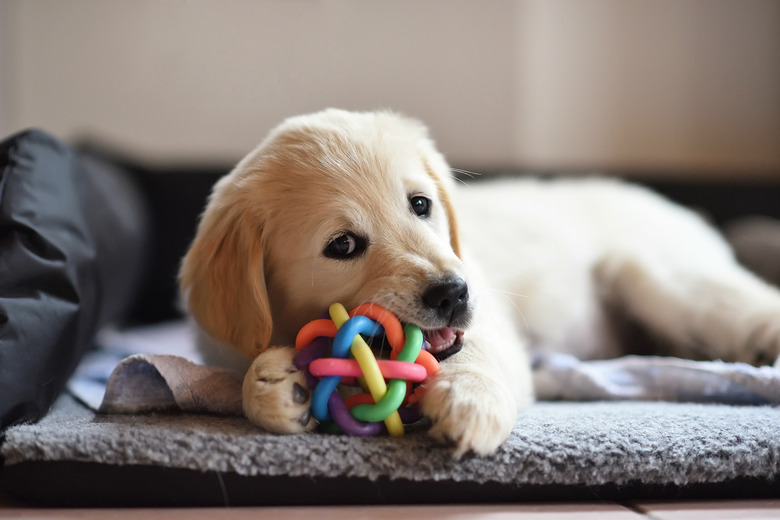When Do Puppies Shed Their First Coat?
We may receive a commission on purchases made from links.
Cuteness may earn compensation through affiliate links in this article.
We all remember Cruella De Vil's quest for a Dalmatian puppy coat. Fortunately, parents, Perdita and Pongo managed to save their puppies, and 84 others, for a total of 101 Dalmatians. If Cruella had succeeded, however, she would have been disappointed, because those Dalmatian puppies may not yet have developed those telltale spots. Dalmatian puppies are born white, but they sport their classic spotted coat by the time the puppy coat sheds out.
The puppy coat
The puppy coat
A puppy is born with one single coat of soft fur, even if it is a double-coated breed. When he sheds that puppy coat — usually between four months and six months old — his new, adult coat will come in stiffer and thicker, according to the American Kennel Club. The double-coated dog will grow two layers of fur after shedding the puppy coat. The puppy's coat pattern and texture may also change. Some breeds such as the pomeranian don't get their full adult coat until they are two years old.
It's important to get your pup used to basic grooming procedures even before his adult coat comes in. Massage your puppy with a soft-bristled curry brush such as the Frisco Rubber Duck Cat & Dog Curry Brush which has soft rubber tips that many dogs enjoy.
Avoid using metal wire slicker brushes or stiff-bristled brushes on your pup at this stage of life. A soft-bristled brush such as Poodle Pet's soft-bristled dog brush can remove dirt, debris, and tangles from puppy hair of both smooth and rough-coated breeds while giving your young dog a positive and pleasurable grooming experience.
Shedding their coat
Shedding their coat
When a puppy's first coat sheds out, the change might be so gradual that you barely notice it. However, some puppies shed their coats quite quickly, resulting in a dramatic difference. Until her mature coat comes in, your pup might look a bit bedraggled, which some breeders refer to this time as the "puppy uglies."
Breeds such as poodles that are considered non-shedding tend to have a less noticeable transition. That doesn't mean a non-shedding breed puppy won't shed his first coat. However, you're not as likely to notice such shedding as you are in a double-coated breed, which will have an undercoat and top coat when the adult coat comes in.
Grooming during puppy shedding
Grooming during puppy shedding
The puppy coat shedding period is an awkward phase for a young dog. Chewy notes that this is especially true of double-coated breeds, who tend to look "bedraggled" during this period. Regular brushing can help your dog's coat look better, and it's a good way to bond with your puppy. Just make sure to use the right grooming tools for your animal's coat. A smooth-coated dog should do just fine with a brush, but other coat types require specific grooming equipment.
Use a slicker brush for double-coated breeds, as well as a wide comb if your pet has long hair. If your dog sports a wire coat, she needs a slicker and a stripping comb. Begin with the stripping comb, which thins the coat and help prevent matting and tangling. If your dog has a curly coat, use a soft slicker brush and brush against the way the hair grows to make the coat look fluffier.
Ruff 'N Ruffus Self-Cleaning Slicker Brush + Pet Nail Clippers + Steel Comb delivers grooming basics necessary to keep your wire-haired dog tangle-free. A push of the button on the slicker brush retracts the wire bristles and lets you remove the hair captured by the brush without accidentally damaging, bending, or poking yourself with the metal wires.
Shedding, of course, can mean your home soon looks like Dog Hair City. While you can't eliminate all that loose hair, regular brushing means less of it gets on your clothing and furniture. Furminator de-shedding tools come in varieties for both long-haired and short-haired dogs, with the stainless edge targeting the undercoat without damaging the topcoat or skin.
A high-quality dog food promotes healthy hair growth and may reduce excessive shedding. Your vet can recommend coat supplements that aid in shedding minimization. A nutritional supplement designed to keep a dog's skin healthy such as Shed-X Dermaplex Shed Control Nutritional Supplement for Dogs can also prevent redness, itching, and excess shedding. The veterinarian-innovated formula contains optimal levels of antioxidants, vitamins, Omega 3 & 6 Fatty acids, and minerals to maintain your dog's optimal fur and skin condition.
Color changes
Color changes
Once a puppy finishes shedding out his coat, you may find your canine is a different color. In most dogs, the difference isn't extreme, but there are exceptions. Generally, the adult coat is darker than the puppy coat, but the opposite also occurs. If you want a purebred dog of a particular shade, do your research beforehand to make sure a dark little puppy doesn't turn into a light-coated adult or vice versa.
Puppy shedding issues
Puppy shedding issues
While the shedding of that initial coat is normal, there are hair loss issues that point to health problems. Take your pet to the vet if she develops bald patches, or her skin appears inflamed or scaly. Consult your vet about a good flea and tick preventive so your puppy doesn't start itching and losing hair due to parasites. Allergies can also cause puppy fur loss.
Always check with your veterinarian before changing your pet's diet, medication, or physical activity routines. This information is not a substitute for a vet's opinion.
